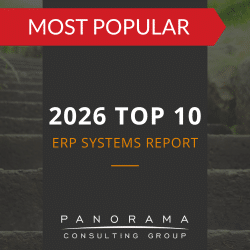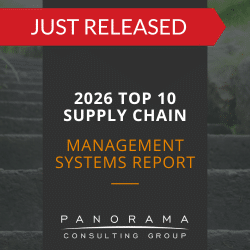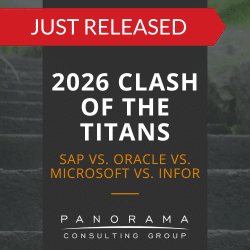When ERP implementations fail, the consequences can be significant and far-reaching.
Two global giants in the confectionery industry—Nestlé and Hershey’s—have each experienced their own tumultuous journeys with ERP (enterprise resource planning) systems. Both companies sought to revolutionize their operations by adopting new ERP solutions, yet both faced unexpected challenges and severe disruptions.
This post explores the ERP failures of Nestlé and Hershey’s, highlighting key lessons for avoiding similar pitfalls.
An Overview of Nestlé’s and Hershey’s ERP Implementations
Nestlé and Hershey’s both embarked on ambitious ERP projects to streamline their operations, enhance efficiency, and boost competitiveness. However, their paths were marred by various challenges, leading to significant operational and financial consequences.
A Failed Payroll System Implementation
Panorama’s Expert Witness team was retained to provide a forensic analysis and written report to the court regarding the failed implementation of a major software developer’s ERP/payroll system.
Nestlé’s ERP Journey
In the late 1990s, Nestlé initiated a $210 million project to unify its various business processes across different regions by implementing SAP’s ERP software.
The company aimed to consolidate its 29 different business units, each of which had its own distinct processes, into a single standardized system. The goal was to achieve better data visibility, more accurate forecasting, and streamlined supply chain management.
Despite its ambitious vision, the project faced challenges right from the start. Misalignment between business processes and ERP capabilities, resistance to change, and communication breakdowns led to delays, cost overruns, and frustration among employees and stakeholders.
The project, originally slated for completion in two years, took nearly five years and cost over $500 million—more than double the initial estimate.
Hershey’s ERP Journey
Hershey’s embarked on its ERP journey in 1996 with an even more aggressive timeline. The company aimed to implement a new ERP system, combined with supply chain and customer relationship management (CRM) software, within 30 months.
Hershey’s goal was to improve its order processing capabilities and overall supply chain efficiency. However, the rush to meet the critical go-live date ahead of the Halloween and Christmas seasons in 1999 led to severe complications.
The system went live in July 1999, but Hershey’s immediately encountered major issues: order processing slowed to a crawl, shipments were delayed, and inventory levels could not be managed effectively. The end result was a 19% decline in quarterly profits, a drop in stock price, and a significant loss in market share.
The timing of the ERP failure, coinciding with peak demand periods, amplified its negative impact.
4 Lessons Learned from Nestlé’s and Hershey’s ERP Failures
These two cases of ERP failures reveal several key lessons for organizations embarking on similar IT projects. Both Nestlé and Hershey’s ERP failures were driven by a combination of factors, including inadequate planning, rushed implementations, misaligned processes, and poor change management.
1. The Importance of Realistic Timelines and Phased Implementations
Hershey’s ERP project was characterized by an overly ambitious timeline. By attempting to implement multiple systems (an ERP, CRM, and SCM system) simultaneously within a 30-month period, Hershey’s set itself up for failure.
The company’s aggressive timeline did not account for the complexities of integrating multiple software solutions, leading to rushed testing phases and insufficient preparation for the system go-live.
Nestlé, although not as rushed as Hershey’s, also faced delays because of the underestimation of time required to align its multiple business units under a single ERP framework.
The Lesson:
Setting realistic timelines is critical for successful ERP implementation. Organizations must allocate sufficient time for planning, testing, and phased rollouts. Key strategies for avoiding IT failures include:
- Phased Implementation Approach: Implement the ERP in phases, starting with non-critical modules, to identify and resolve issues early. This approach minimizes risk and allows for smoother user adoption.
- Comprehensive Testing: Ensure that thorough testing is conducted at each phase of implementation to catch issues before they escalate. Include stress testing to determine how the system performs under peak loads.
- Adjusting Deadlines as Needed: Be prepared to extend project timelines if issues are identified. It’s better to delay the go-live date than to launch a misaligned or faulty system.
2. Align Business Processes with ERP Capabilities
Nestlé’s ERP failure was partly due to a significant misalignment between its existing business processes and the standardized processes embedded in SAP’s ERP system.
Instead of adapting its processes to fit the new system, Nestlé attempted to customize the software extensively to match its existing operations. This decision led to increased complexity, higher costs, and ongoing challenges in maintaining and updating the system.
Similarly, Hershey’s ERP project also struggled with aligning new software functionalities with existing business processes. In Hershey’s case, this misalignment resulted in significant order fulfillment delays and inventory management issues, ultimately impacting the company’s financial performance during a critical sales period.
The Lesson:
To avoid ERP failure, organizations should focus on aligning their business processes with the capabilities of the chosen ERP system. Excessive customization can lead to unnecessary complexity and costs.
Our computer software expert witnesses have analyzed many ERP failure cases, and one of the pitfalls they frequently report is a failure to assess the software’s compatibility with existing processes. Key strategies for avoiding over-customization include:
- Process Standardization: Map out existing business processes and compare them with the ERP system’s standard functionalities. Identify areas where standard processes can be adopted. An independent third party can help you validate these processes against industry norms and highlight potential pitfalls.
- Minimizing Customizations: Limit customizations to those that are absolutely necessary to meet unique business needs, and adopt best practices already embedded in the ERP system where possible.
- Engaging Stakeholders Early: Involve stakeholders from different departments in process mapping and system selection to ensure alignment between the ERP solution and business needs.
3. Organizational Change Management is Critical to Success
Both Nestlé and Hershey’s underestimated the importance of organizational change management in their ERP implementations.
At Nestlé, resistance to change was a significant barrier. Employees were not adequately prepared or trained to use the new system, leading to confusion and frustration.
Hershey’s also faced change management issues, with employees struggling to adapt to the new system during a critical sales period, compounding operational disruptions.
The Lesson:
A robust change management strategy is essential for the success of any ERP project. Organizations must proactively address the human element of ERP implementation by preparing employees for the transition and ensuring they are comfortable with the new system. Key steps include:
- Comprehensive Training Programs: Develop detailed training programs tailored to different user groups. Ensure that all employees understand how to use the system effectively.
- Clear Communication Plans: Communicate the reasons for the ERP implementation, its benefits, and what is expected from employees. Regular updates should be provided to keep everyone informed and engaged.
- Continuous Support: Offer ongoing support post-implementation to address any issues and reinforce learning. This support can include dedicated help desks, online resources, and regular refresher courses.
4. Strong Governance and Leadership are Non-Negotiable
In both cases, governance and leadership failures played a significant role in the ERP project breakdown.
Nestlé faced challenges in aligning its multiple business units under a single governance framework, leading to conflicting priorities and inconsistent decision-making.
Hershey’s leadership pushed for a tight implementation timeline to meet seasonal demand, prioritizing speed over project readiness, which led to disastrous results.
The Lesson:
Effective governance and strong leadership are critical for steering ERP projects towards success. Leaders must establish clear governance structures and ensure consistent oversight throughout the project. Key success factors include:
- Establishing a Governance Framework: Develop a clear governance structure that defines roles, responsibilities, and decision-making processes. This structure should enable coordination among different business units and stakeholders.
- Consistent Leadership Involvement: Ensure that senior leadership is actively involved in project oversight. Regular updates should be provided to executives to keep them informed and engaged.
- Empowering Oversight Committees: Establish oversight committees that include key stakeholders from across the organization. These committees should be empowered to make decisions, intervene when necessary, and provide feedback on project progress.
The Ripple Effects of ERP Failure
The ERP failures of Nestlé and Hershey’s serve as stark reminders of the complexities involved in implementing large-scale IT projects. A computer software expert witness can discuss these complexities in detail, but for now, a “gut check” to keep you on the right track might be the only thing you need.
If your organization is facing ERP implementation challenges, contact us for a free ERP consultation and “gut check.” Our ERP implementation consultants can help you navigate the complexities and avoid the pitfalls of poor IT project management.














